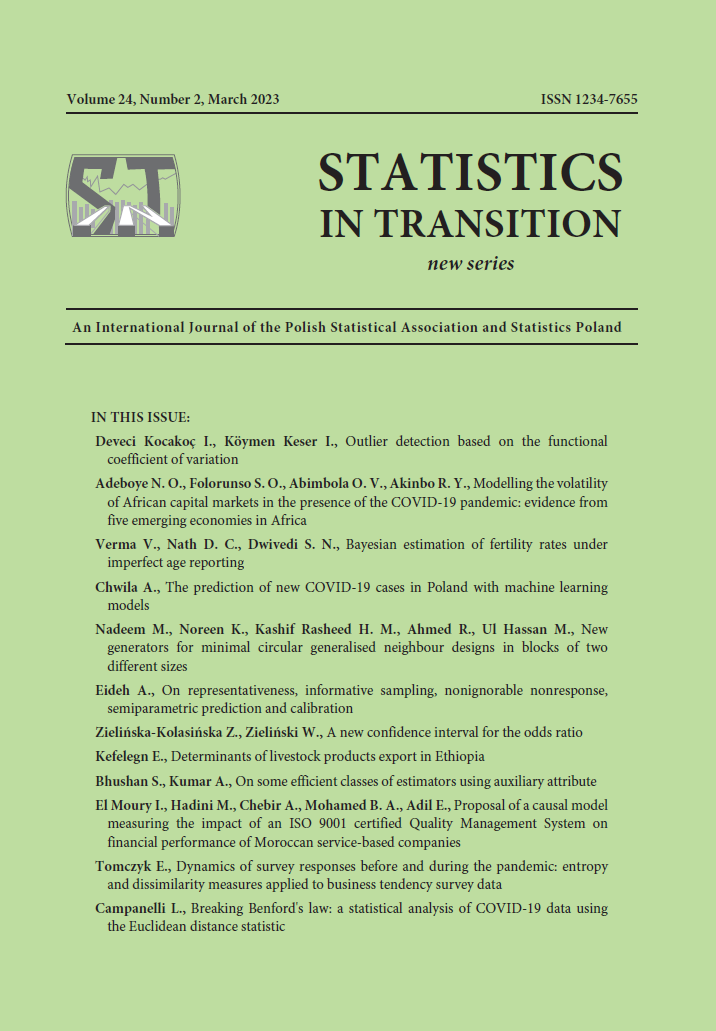ARTICLE
ABSTRACT
Using the Euclidean distance statistical test of Benford’s law, we analyse the COVID-19 weekly case counts by country. While 62% of the 100 countries and territories considered in the present study conforms to Benford’s law at a significant level of α = 0.05 and 17% at a significant level of 0.01 ≤ α < 0.05, the remaining 21% shows a deviation from it (p values smaller than 0.01). In particular, 5% of the countries ‘break’ Benford’s law with a p value smaller than 0.001.
KEYWORDS
Benford’s law, COVID-19 data
REFERENCES
Benford, F., (1938). The Law of Anomalous Numbers. Proceedings of the American Physical Society 78, pp. 551–572.
Campanelli, L., (2021). On the Euclidean Distance Statistic of Benford’s Law. Communications in Statistics - Theory and Methods. DOI: 10.1080/03610926.2022.2082480.
Campanelli, L., (2022). Testing Benford’s Law: from small to very large data sets. Submitted to Spanish Journal of Statistics.
Cho, W. K. T., Gaines, B. J., (2007). Breaking the (Benford) Law: Statistical Fraud Detection in Campaign Finance. Am. Stat. 61, pp. 218–223.
Facchinetti, S., (2009). A procedure to find exact critical values of Kolmogorov-Smirnov test, Ital. J. Appl. Stat. 21, pp. 337–359.
Farhadi, N., (2021). Can we rely on COVID-19 data? An assessment of data from over 200 countries worldwide. Sci. Prog. 104, pp. 1–19.
Goodman, W., (2016). The promises and pitfalls of Benford’s law. Significance 13, pp. 38–41.
Hill, T. P., (1995a). The significant-digit phenomenon. Am. Math. Mon. 102, pp. 322–327.
Hill, T. P., (1995b). Base-invariance implies Benford’s law. Proc. Am. Math. Soc. 123, pp. 887–895.
Hill, T. P., (1995c). A statistical derivation of the significant-digit law. Stat. Sci. 10, 354– 363.
International Health Regulations, (2005). The document can be observed at https://www.who.int.
John Hopkin University, (2021). https://www.ghsindex.org.
Leemis, L. M., Schmeiser, B. W., Evans, D. L., (2000). Survival Distributions Satisfying Benford’s Law. Am. Stat. 54, pp. 236–241.
Miller, S. J. (ed.), 2015. Benford’s Law: Theory and Applications. Princeton. Princeton University Press.
Morrow, J., (2014). Benford’s Law, Families of Distributions and a Test Basis. London: Centre for Economic Performance.
Newcomb, S., (1881). Note on the frequency of use of different digits in natural numbers. Am. J. Math. 4, pp. 39–40.
Nigrini, M., (1996). A taxpayer compliance application of Benford’s law. Journal of the American Taxation Association 18, pp. 72–91.
Noether, G. E., (1963). Note on the Kolmogorov statistic in the discrete case. Metrika 7, pp. 115–116.
Pérez-González, F., Abdallah, C. T., Heileman, G. L., (2007). Benford’s Law in Image Processing. IEEE International Conference on Image Processing, pp. 405-–408.
Roukema, B. F., (2013). A first-digit anomaly in the 2009 Iranian presidential election. J. Appl. Stat. 41:1, pp. 164–199.
Sambridge, M., Tkalˇci´c, N., Jackson, A., (2010). Benford’s law in the natural sciences. Geophys. Res. Lett. 37, L22301.
Sambridge, M., Jackson, A., (2020). National COVID numbers - Benford’s law looks for errors. Nature 581, p. 384.
Wei, A. and Vellwock, A. E., (2020). Is COVID-19 data reliable? A statistical analysis with Benford’s law. DOI: 10.13140/RG.2.2.31321.75365/1.
World Health Organization, (2021). https://www.covid19.who.int.
